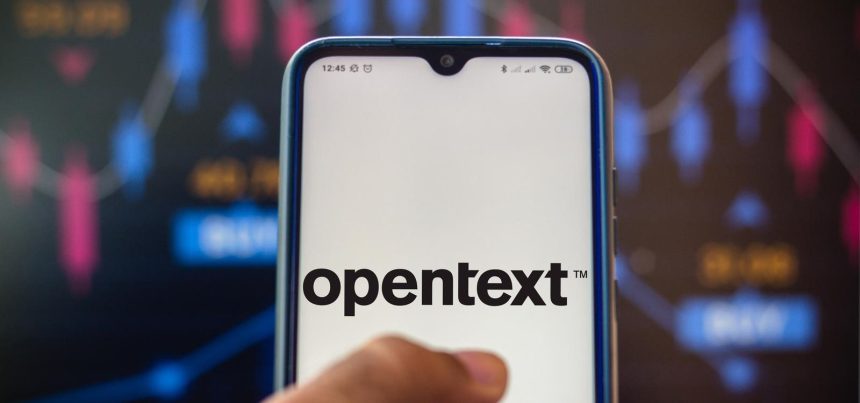Open Text (OTEX) reported solid quarterly results on May 2. Fiscal 2024 Q3 revenue rose 16.3% year-over-year to a third-quarter record $1.45 billion and came in $13 million ahead of consensus as OTEX benefited from the January 2023 acquisition of rival Micro Focus—which added $190 million more to the top line than in the prior-year quarter—and continued strong performance in its existing operations. This includes the 13th consecutive quarter of growth for currency-adjusted cloud services and subscriptions revenue. Combined with an adjusted gross margin that widened to 76.7% from 75.8%, this more than made up for the inclusion of Micro Focus’s lower-margin operations and the higher interest expense associated with the debt taken on to finance the deal and drove a 28.8% climb in adjusted earnings to 94 cents per share, which met analysts’ expectations.
Unfortunately, this hasn’t prevented OTEX’s shares from tanking 14% on the company’s revised forecast for the year. The company reduced its revenue outlook for the full 2024 fiscal year to a range of $5.75 billion to $5.80 billion, which is $130 million lower than its prior guide of $5.85 billion to $5.95 billion. But the stock’s slide, which comes on top of the 22% it had already been down from its February 2 high before the report is much too severe when you realize that this cut in outlook is largely due to the earlier-than-anticipated completion of the divestiture of its Application Modernization and Connectivity business to Rocket Software on May 1, which was expected to contribute $100 million to the top line through June 30. Similarly, a $100 million reduction to expected free cash flow is the result of the missing two months of contribution which is almost entirely due to losing the two extra months of cash flows it would have seen from the divested division as well as $40 million of costs related to the sale.
Even the reduced targets still indicate strong top-line growth of at least 28% from fiscal 2023 thanks to contributions from the acquisition and an increase of 1% to 2% from its other operations. The latter reflects the payoff from the strong enterprise cloud bookings over the past several quarters, growth of which is now expected to accelerate to 33%-38% from a previously forecast 25%-30% and up from just 9.5% last year. And even as OTEX also reduced its adjusted Ebitda margin guidance by 2.5% to a new range of 33.5%-34.5%, this still represents a meaningful expansion from the 32.8% achieved in fiscal 2023. This is also why even its lowered free cash flow forecast of $725 million to $800 million still reflects solid growth of about 16% from the $655 million generated last year.
Open Text (OTEX) is one of the stocks recommended in our market-beating investment newsletter, Forbes Investor. To discover more undervalued gems with significant upside like OTEX, try Forbes Investor for FREE.
When you also consider that OTEX subsequently used the entire net proceeds of $1.93 billion from the sale of the Application Modernization and Connectivity division to pay down debt, its net debt balance and leverage ratio should have declined from the elevated $7.2 billion and 3.8 the company ended the latest quarter with to a much more manageable $5.3 billion and less than 3.0 at present. As such, OTEX will enter fiscal 2025 in July with significantly better financial flexibility to accelerate its move into growth areas such as cloud and artificial intelligence capabilities. Combined with the roughly $154 million in annual interest costs it expects to save from the debt reduction, this has it eyeing free cash flow expansion to $1.2 billion to $1.3 billion over the next three years even without its Application Modernization and Connectivity business in the fold. This would mark a doubling from the $575 million to $650 million in free cash flow targeted for fiscal 2025. If so, I wouldn’t be surprised to see the stock rebound by a similar amount over that span.
Julius Juenemann, CFA is the equity analyst and associate editor of the Forbes Special Situation Survey and Forbes Investor investment newsletters. Open Text (OTEX) is a current recommendation in the Forbes Investor. To access this and the other stocks being recommended through the Forbes Investor, click here to subscribe.
Read the full article here
















